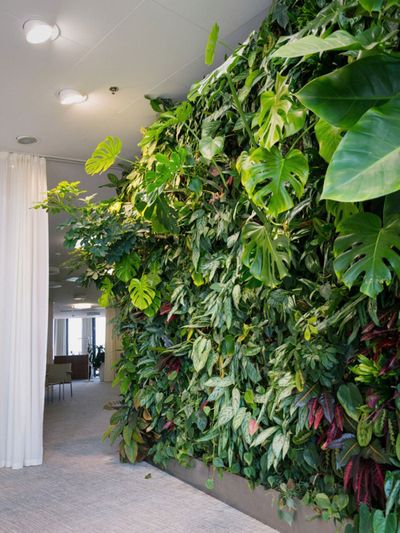A vertical garden in an apartment may be the just the thing for plant lovers who are short on space. Vertical gardening indoors isn’t difficult, and hundreds of plants are suitable for growing vertically indoors. Take time to plan carefully and make the best use of available space.
Vertical Gardening Inside
Indoor vertical gardens must be attached to sturdy supports. Pots filled with plants and damp potting mix are heavy. You may want to protect the supporting wall with a sheet of plywood behind the vertical garden. Alternatively, protect the wall from moisture with polyethylene cloth. Indoor vertical gardening can get messy, but a sturdy, rubber-backed mat or rug placed beneath the vertical wall will protect your floor from occasional drips. If your apartment is short on sunlight, you can always supplement available light with grow lights or fluorescent tubes. A timer is easy to install and ensures lights are turned on and off on schedule. A fan placed near an indoor vertical garden improves air circulation and improves the growing environment around your plants.
Indoor Vertical Gardening Ideas
A vinyl shoe organizer makes a cute and inexpensive planter for growing vertically indoors. Just attach the organizer to a wooden or PVC frame or a piece of lattice to protect the wall. Put miniature plants in nursery pots directly in the pockets. You can easily remove the pots for watering, or to experiment with plant placement. If you have a bright, sunny window, use sturdy brackets to mount two or three curtain rods across the window. Fill small tin buckets with plants of your choice, then use ‘S’ hooks to hang the buckets from each rod. Create a tiered hanging with two or more woven baskets filled with plants. For a towering appearance, use graduated sizes, with the smallest basket on the top and the largest on the bottom then connect the plants with sturdy polyester rope. Plant in removable pots to simplify watering.
Choosing Plants for an Indoor Wall
Consider your growing conditions before choosing houseplants for indoor vertical gardens. For instance, will your vertical garden be in bright light, partial light, or shade? Also, think about what type of plant will work best. Will your vertical garden accommodate large or small plants? Should plants for an indoor wall be hanging, upright, or a combination? Don’t hesitate to experiment and see what works best. Here are a few easy houseplants for growing vertically:
Philodendron (Philodendron sp.): Having bright green, heart shaped leaves, philodendron is a fast growing, dependable climbing plant that grows nearly anywhere with very little attention. If you’re a beginner when it comes to houseplants for growing vertically, this is a fantastic choice.
Ferns: Ferns such as sword fern (Nephrolepis exaltata), rabbit’s foot (Davallia fejeensis), or medusa (Nephrolepis obliterata) are great houseplants for indoor vertical gardens. These adaptable plants generally need a little extra moisture. Bright, indirect light is ideal. Most ferns grow relatively quickly.
Air plants (Tillandsia): Air plants are members of the bromeliad family. They are fun little plants available in hundreds of interesting species. Air plants thrive in bright, indirect light. They absorb moisture and nutrients not through roots, but through their leaves. Just soak the plants in room temperature water every couple of weeks, depending on humidity levels in your home. No other care is needed.
Lipstick plant (Bixa orellana): Lipstick plant is a cascading plant with shiny green leaves and red, lipstick shaped blooms that show up throughout the year. This hardy plant, one of the best plants for an indoor wall, tolerates low light and dry conditions like a champ. Let it trail or train it to climb up a support.
Pothos (Epipremnum): A low maintenance plant with a graceful growth habit and lovely, heart shaped leaves. Pothos tolerates nearly any light, including bright sunlight or semi-shade. Look for varieties with yellow, blue, or neon leaves or green foliage marked with white, cream, or gold. This plant is suitable for hanging or climbing.
Baby’s tears (Soleirolia soleirolii): Baby’s tears form a soft mat of tiny, bright green leaves. Although this dainty plant prefers moderate light, bright light is acceptable if it isn’t too intense. Keep the soil somewhat moist but never soggy.
Herb plants: If you’re looking to grow herbs, choose those that mature fairly quickly and don’t produce long roots. If your growing space is in low light, consider mint or lemon balm. Basil, chives, purslane, and parsley do well in partial shade while herbs like sage, thyme, and cilantro thrive in bright sunlight.
